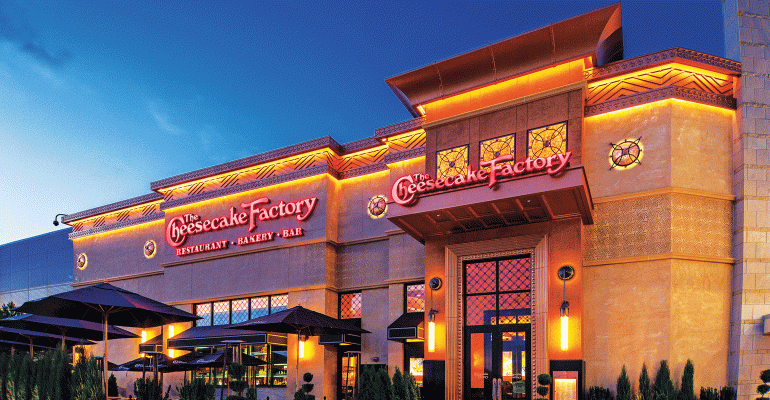The noticeable contraction of brick-and-mortar retailers in the Internet Age hasn’t produced much of an easing in restaurant operators’ real estate costs, but it does offer brands a chance for more marquee sites.
Landlords from big shopping malls to neighborhood lifestyle centers in the past year have seen a tsunami of traditional retailers shutter their doors. Land owners, in turn, have courted restaurant brands for those abandoned locations.
Hundreds of traditional brick-and-mortar locations in both shopping malls and strip centers have announced closures.
Wayne, N.J.-based Toys “R” Us announced in late March that it was closing its 735 stores in the United States. Teen apparel company Abercrombie & Fitch said it would not renew leases on about 60 stores as they expire this year. Clothing brand J. Crew said it will be closing 20 stores this year, after shutting down 50 in fiscal 2017. Shoe store Foot Locker announced it will be closing 110 stores this year. And big-box department stores like J.C. Penney, Macy’s, Sears and K-Mart, Bon-Ton Stores Inc. and Sam’s Club have continued closures into this year.

Toys
Within the restaurant industry, Seattle-based Starbucks Corp. closed all 379 of its Teavana retail locations last fall, even as chairman Howard Schultz was eyeing larger locations for the coffee chain’s larger, destination-oriented Roastery and Reserve stores.
“Howard Schultz got some real estate discussions started when he was under fire for some of the size and scope of his Roasteries,” said John Gordon, principal in the San Diego, Calif.-based Pacific Management Consulting Group.
Schultz, in a memo to employees last fall, said he had seen an "abundance of empty storefronts across the country" in prime locations.
"This is good news for Starbucks and the future of our unit economics," he wrote. "This is not going to be a cyclical change in our occupancy expenses, but a permanent lowering of the cost of our real estate.”

Starbucks Corp. closed all 379 of its Teavana retail locations last fall, even as chairman Howard Schultz was eyeing larger locations for the chain's Roastery and Reserve stores (right).
Rising rents
Still, consultant Gordon said that rental rates generally have been inching upward.
“In urban areas and all the cool areas where restaurateurs want to be in, I haven’t seen any movement,” Gordon said, adding that lease roll-overs for older legacy brands could produce higher rents and common area maintenance, or CAM, fees.
“We all want to be at 5 percent for rent and CAMs,” Gordon said. “That’s a pipe dream now. I’m seeing data that rent costs … depending on the mix of legacy and new stores, have probably risen one full percentage point or 100 basis points over the last couple of years.”
Those higher rental costs are becoming the norm, he said.
“Restaurateurs are getting more used to 7 or 8 percent rent (of sales) and trying to make it work,” he said.
A 2018 forecast by the Buxton customer analytics firm, based in Fort Worth, Texas, and with more than 4,000 clients in the retail, restaurant, healthcare, private equity and public sectors, found mall pricing had inched up from the financial crisis of 2008 and 2009.
“While pricing in both primary and secondary markets has completely recovered from the global financial crisis, primary market pricing is 1.5 times the previous cycle peak,” Buxton said in its “State of the Retail and Restaurant Real Estate Market” report. “Secondary market pricing, by contrast, has reached 1.1 times the previous peak and is expected to climb even higher.”

Remaking the mall
Some shopping centers are working to replace traditional retailers with new restaurant areas that are a giant step up from the food courts of yore.
Restaurant brands long associated with mall locations see themselves continuing to be draws, such as Calabasas, Calif.-based Cheesecake Factory.
Matt Clark, Cheesecake Factory chief financial officer, said 85 to 90 percent of the brand’s guests still consider it a “destination.”
“I think there is definitely the headwind in the malls,” Clark said in February, so the brand is putting more efforts behind driving traffic through social media and convenience.
Clark said Cheesecake factory is “looking at other ways to drive convenience for those guests who might not want to come to the mall through delivery or a to-go experience through online ordering.
“We think that's a more effective way in conjunction with the social media platforms than just sort of traditional marketing,” Clark said.

Those changes in marketing reflect disruption through the retail space, but experts say there is no death knell for brick-and-mortar locations.
Chris Briggs, senior vice president at Buxton, said mall real estate competition will remain intense.
“Brick-and-mortar will not go away, but it is certain to continue to evolve — often rapidly,” he said. “Keep nimble and quick to strike on opportunities and mitigate threats as they emerge. Know your customer and keep that knowledge contemporary and close at hand always.”
Top-notch real estate will always earn a premium, he added.
“The competition for quality, upper mid-market to higher end retail space is going to remain very high,” Briggs said. “There is just a lot of inventory out there that is sub-optimal. It is sub-optimal for a reason.”
Evolving the experience
Food and beverage options play a big part in the evolution of retail, said Peter Healey, a Buxton vice president.
“Malls aren’t dying, but they are evolving,” Healey said. “As with any evolution, some malls in ‘bad’ trade areas are going to become extinct while malls in ‘good’ trade areas will continue to thrive. The key to prosperity is proper alignment of tenants and trade-area households. Being the most convenient option for the best types of customers will provide a viable path forward.”

Buxton citied recent a recent study of 90 regional shopping centers and found that renovations were topped by food and beverage enhancements, with 41.1 percent citing them; followed by tenant upgrades, at 34.4 percent; entertainment additions, at 28.9 percent; and “de-malling” — or entirely removing “mall” from the name, at 16.7 percent.
Alternative uses will be most common at malls where the trade area has shifted to the point that traditional retailing no longer made sense.
Consultant Gordon agreed, saying restaurant sales are often among the first harbinger of neighborhood that is changing in demographic makeup.
Buxton noted that the United States has more retail space per capita than most other nations, citing figures from the Urban Land Institute.
“The United States, with more than 24.5 square feet of retail space per capita (more than five times Europe’s average of 4.5 square feet), includes over 8.5 billion square feet of retail, with perhaps 3 billion square feet underused in terms of sales volumes supported and vacancy rising,” the Urban Land Institute noted late last year.
 Bill Bayne, co-founder of the Dallas-based Fish City Grill, said his 19-unit casual-dining brand in four states has changed its focus on seeking real estate.
Bill Bayne, co-founder of the Dallas-based Fish City Grill, said his 19-unit casual-dining brand in four states has changed its focus on seeking real estate.
“We used to seek lifestyle centers or smaller centers that had a higher end women's apparel component: White House-Black Market, Coldwater Creek, etc.,” he said. “A big book store was a big plus as well.” The company avoided shopping areas that were anchored by groceries.
That has a change, however, with prime considerations being for locations that are easier for customers access, such as parking lots that are nearby and easy to access.
“Synergy with other restaurants is important,” he said.
Buxton noted that restaurant brands are looking to create locations that provide a better overall customer experience.
“In an age where consumers love to document and share unique dining experiences on social media, traditional chain restaurants are finding that they need to innovate to compete,” the company said in its 2018 forecast. “For example, Starbucks is investing in ‘Roasteries’ that allow customers to experience the process of creating a cup of coffee from start to finish.”
Restaurant operators need to always evaluate whether the areas nearby real estate have demographics to support the concept, Gordon added.
“Every lease should have a tenancy clause for an ‘X’ number of tenants,” he said. “There has to be a certain element of mall vibrancy that comes from the landlord, and that has to work its way into the lease agreement.”
Contact Ron Ruggless at [email protected]
Follow him on Twitter: @RonRuggless

